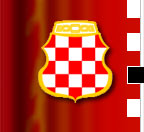|
Medieval
Bosnia shared many characteristics with other South-Slavic
states of the period. That political domain (not a state!)
was established as a military commonwealth and functioned
as a patriarchal family. Historian Nada Klaic makes a connection
between the creation of the Bosnian political domain and the
dominion of the Avars where the term "Ban" (used
by Croatian and Bosnian leaders) originated. The Bosnian lands,
having been politically organized along the same lines as
the other South Slav countries, from the outset enjoyed independence
which was to last for another 400 years.1
The core
of the old Bosnian state (see map 19) was geographically nested
within regions that the Bosnian core gradually annexed. The
river Drina separates the Bosnian core from Serbia, and the
Serbian king Nemanja's state never crossed the river, but
rather directed its expansionary efforts at the Zahumlje region
(maps 4 and 5). Eventually, after many changes of fortune,
Zahumlje was incorporated into the Bosnian state, and on the
eve of the Ottoman occupation, that was a region under the
control of Herceg (Duke) Stjepan Vukcic. This region eventually
assumed the name of Hercegovina, but the name Dalmatia is
evident on most older maps. Hercegovina was a subordinated
and a less common term. On some maps, this region is termed
Turkish Dalmatia.1a
Regions
north, west and south of the historical core naturally gravitated
towards Croatia, and the medieval histories of Croatia and
Bosnia are intertwined. Bosnia expanded territorially onto
historical Croat regions (compare map 19 with map 11),
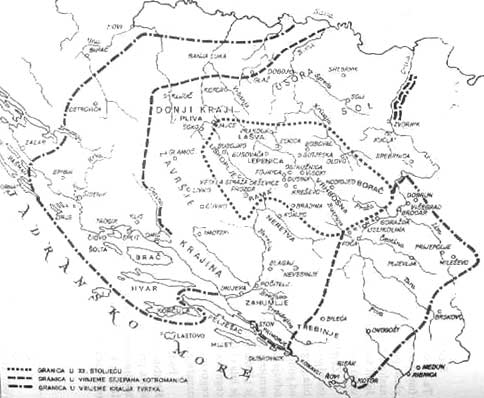
Map
19
The growth of Bosnia
(T. Macan "Povijest hrvatskog naroda")
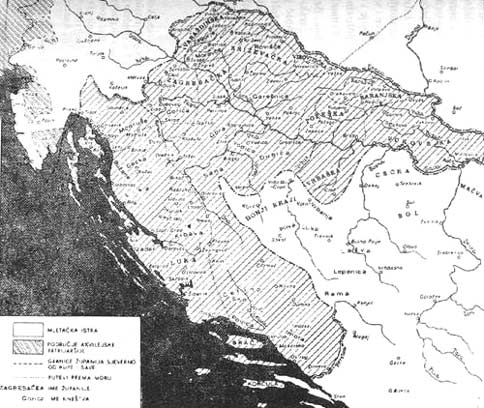
Map
11
The growth of Bosnia towards Croatian historical lands
and King
Tvrtko (1353-1391) ruled over regions east of Drina. After
Tvrtko's passing, Bosnian aristocrats each ruled over specific
regions, including historical Croatian regions (map 20).
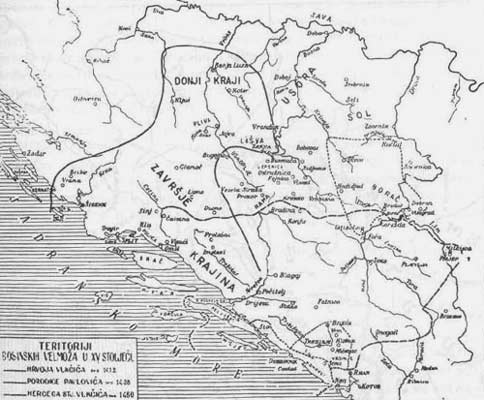
Map
20
The territories of Bosnian lords in the 15th century
(F. Sisic "Povijest Hrvata u vrijeme narodnih vladara")
By the
end of the 16th Century, the Ottomans formed one Pashaluk
(a military territorial
unit), encompassing the Bosnian kingdom and other regions
won from Croatia (Sanjaks/provinces Pakrac, Bihac, Klis and
Hercegovina). The Croatian historical regions on the western
part of the Pashaluk were called "Turkish Croatia"
on many older maps. Sanjaks Pozega and Srijem were outside
the Bosnian Pashaluk, and these were collectively called Turkish
Slavonia. Due to turbulent historical circumstances, a large
part of Croatia's historical territories is now a part of
Bosnia and Hercegovina. Old maps clearly show that the border
between the Ottoman Bosnia and Serbia is the river Drina.

The uniqueness of Bosnia
Since
there were no adherents of the Orthodox faith in Bosnia before
the arrival of the Ottomans, it can be concluded that the
direct descendants of the indigenous population are today's
Croats and Bosniaks-Muslims. One of the facts that proves
this is the use of the "ikavica" sub-dialect by
both national groups. In the old Bosnian state, court, aristocracy
and the commoners in addition to "ikavica" used
some other terms, specific to Croats.6 Ancient Croatian Slavic
names for months of the year are a good example (sicanj, veljaca
etc.). The dialect used in Bosnia before the Ottoman conquest
confirms that Bosnia was inhabited by compact population using
a western version of the "stokavski" dialect which
is a lot closer to the "cakavski" and "stokavski"
than to the eastern "stokavski" dialect (map 4).
Using archeological, anthropological and linguistic criteria
we can conclude that today's Croats and Bosniaks-Muslims belonged
to the same medieval ethnicity, from which throughout the
centuries two modern nations have been forged through the
crucible of frequently conflicting religious, political, cultural
and societal identities and loyalties. To conclude that Croats
and Bosniaks-Muslims have the same roots does not mean that
the latter are Croats. The process of separation took a long
time, and started at a time when there were no nations in
the modern sense of that word in the region. Not even the
fact that specifically Croat terms7 were used for Bosniaks-Muslims,
their language and land during the Ottoman times can't be
used as a convincing argument to consider them as an integral
part of Croatian nation "led astray" by deceptions
and ironies of history. A sense of "belonging" to
a modern nation is a matter of free choice which has passed
through various mutations in the course of alternated historical
circumstances. The creation of separate Croat and Muslim nations,
with a major role played by religion, is a good example how
nations came into existence in this region. We will later
analyze how Muslims came to exist in Bosnia through the process
of the conversion of the indigenous population to Islam. It
is a fact that many Catholics converted to the new religion,
which also proves that Bosniaks-Muslims emerged out of the
same ethnic substratum from which the modern Croat nation
was created.
The entire
region developed into the dominion ruled by a network of families,
which laid the foundation for the further development. The
Bosnian aristocracy tried to keep their independence and uniqueness,
with the unhappy consequence of parochialism as the
governing principle, which eventually led even to the voluntary
submission and acceptance of the conquering Ottoman despotic
rule in order to preserve certain benefits and elements of
power.

The ethnic character of Bosnia
Arguments
about the early Serb character of Bosnia are quite weak and
very easy to dispel. Annales regni Francorum describe the
rebellion of Croatian war-lord Ljudevit Posavski and mention
that an army was sent against him in 822. "Ljudevit leaves
Sisak and flees to the Serbs, people inhabiting a large part
of Dalmatia." It was already pointed out that nations
of the 19th and 20th centuries can't be mechanically equalled
to those in the early centuries after the arrival of Croats
and Serbs (although the stages and detours of the "birth
of a nation" are still debated among scholars) . These
nations were neither fully formed nor defined in those days
and the casual mention of some ethnic-ringing name can't be
considered as proof that a certain region did or did not belong
to the Croats or Serbs (even in the medieval sense of the
word).
As far
as the "flees to the Serbs" part is concerned, according
to N. Klaic, those Serbs are analogous with a medieval aristocratic
county in the 14th Century (today's town of "Srb"
in the Republic of Croatia). Even linguistically, this has
nothing to do with Serbian people: Srb is a small village
near the spring of the river Una (north of Knin in Croatia).
Serbian linguists see this name as a trace of the Serbian
name (Serb->Srb?). However, according to academician Petar
Simunovic the name of Srb originates from an old Croatian
verb serbati, srebati = to sip, from which the noun "srb"
has been derived. Thus "srb" denotes the spring
of river Una, where the village lies. Similarly, there are
villages of Srbani (near Pula), and Srbinjak, both in Istria
(historically never populated by ethnic Serbs), which clearly
have nothing to do with the Serbian name. The "Istarski
Razvod"/Istrian manuscript from 13th century mentions
the name of srbar, meaning a water spring.
The citation
in the "Annales" is often used as a proof that Bosnia
was under Serb control, but this combination, according to
N. Klaic, is not only wishful thinking, but should be completely
dismissed.12
Byzantine
emperor-turned-historian Constantine Porfirogenet included
the towns of Kotor and Desnik as a part of "small land
of Bosnia". An unreliable author (deeply involved in
rewriting the history as a quasi-ideological weapon in the
contemporary Byzantine territorial disputes) cannot be seriously
accepted as the crucial witness of the far reaching (but shaky,
hanging onto a dubious sentence) argument about the supposed
Serb character of Bosnia. He indicated that he counts Bosnia
as a Serb land, or, to be exact, under Serb political rule.13
But this whole argument is based on Porfirogenet's data that
defines the Serb territories extending as far as the river
Cetina (deep inside today's Republic of Croatia)-which sinks
the "argument" instantly, due to the multitude of
other historical chronicles which are unanimous re the territorial
compass of early Croat historical lands. In fact, these "truths",
all set in advance, distorted and misused by modern Serb nationalism
- a combination that is very dangerous at specific times because
it calls for the "defence of ancient territories".
Serbian version of history is polluted with such "truths",
but Croats also aren't immune to myopic visions of history.
Such shaky
argumentation about "Serbian Bosnia" was not infrequently
combined with the pseudoscholium on the supposedly Orthodox
character of the "Bosnian church".14 Even that attempt,
as far as scholars are concerned, has miserably failed. Arguments
that base the Serbian character of Bosnia on Tvrtko's family
relations to the Nemanjic dynasty through his grandmother
Jelisaveta, are, from an academic standpoint, a ridiculous
example of pathetic hysteriography.
The whole
Bosnian region, with the surrounding Croatian lands, was without
any doubt, Catholic and "Krstjan" (Bosnian "Heretic")
before the Ottoman conquest. It is a fact that the whole region
was under the jurisdiction of several Catholic dioceses.
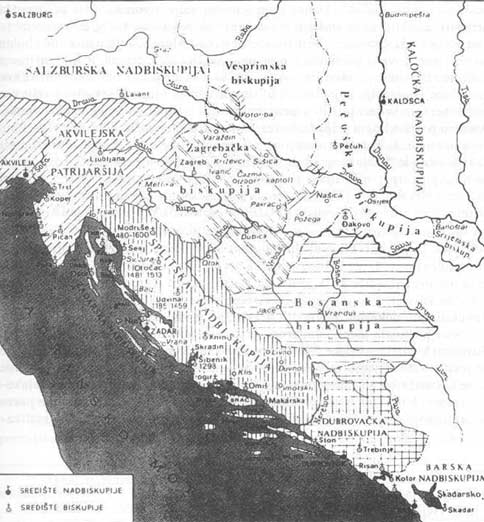
Map
22
The territorial oganisation of churches in Croatia and Bosnia
(N. Klaic "Povijest Hrvata u razvijenom srednjem vijeku")
The Catholic
Church's jurisdiction doesn't mean the complete victory of
Christianity, because across the entire region some Pagan
beliefs survived. That occurrence was characteristic for Western
Europe as well, where in certain regions Christianity achieved
total victory only after a lengthy delay. It is clear that
all necessary conditions were in place for evolution into
a modern Croat nation, as a projected symbiosis, with Catholicism
as a powerful unifying force.
The Croat
character of Bosnia is sometimes argued along the following
lines: Croat rulers reigned, intermittently, over much of
medieval Bosnia. But-successful military operations of Croat
kings and Serb dukes did not translate into permanent political
rule and annexation of territories being fought over.15 The
Croatian character of Bosnia cannot be definitely proven by
the illustrious title "Rex Ramae" used by the Hungarian-Croat
Arpadovic dynasty nor by attempting to portray the Bosnian
aristocracy as being predominantly Croatian in manners and
political affiliation. The term "Ban" is certainly
Croatian in nature, but not even this can be proof that Bosnia
belonged to Croatia. Yes, the rulers of Bosnia called themselves
"Ban", but that doesn't have to mean that Bosnia
was Croatian; rather, Croatian and Bosnian histories have
been interlinked throughout the centuries. Precisely because
of this closeness, similar styles of ruling systems developed
- more specifically, aristocratic dynasties.
Before
the Ottoman invasion, the link between Croatia and Bosnia
was most evident in Church organization. This whole region
was under the jurisdiction of various Catholic dioceses (map
22). The Bosnian "heretic" church owes its existence
to the spread of Gnostic Pataren influences from the west
via Zadar and Split that reached the interior of Bosnia and
Hum (a period term for Hercegovina). The process of integration
of the peoples and regions within a Catholic Croatian framework
was abruptly ended by the Ottomans, who actively engaged in
spreading Islam and, as a side-effect, Orthodoxy (map 3).
Bosnia
developed as a separate state that existed until 1463. Finally,
as a result of the Ottoman invasion, it became a Pashaluk.
However, when medieval Bosnia is discussed today, and the
rights of the indigenous Bosniak-Muslims in it (which is justified),
an important fact is often (deliberately) left unmentioned.
That essential piece of information is that the Bosnian Pashaluk
spread into Croatian territories (map 21). The Christian counter-offensives
in the 17th century reduced the territory of the Pashaluk,
but even so, large tracts of Croatian lands remained in it,
and within today's Bosnia and Hercegovina. Current eastern
borders of Croatia are military borders, established through
peace agreements, while the historic Croat territories stretching
towards rivers Vrbas and Bosna in the central Bosnia and parts
of Montenegro were irrecoverably lost.19 It needs to be pointed
out that undoubtedly Croatian historical lands, such as "Turkish
Croatia" (now, the northwestern third of the contemporary
sovereign Bosnia and Hercegovina), are today completely inhabited
by a non-Croatian population. Ignoring, and deliberately disregarding
(or, sometimes, consciously distorting/obscuring) these facts,
whilst discussing the historical uniqueness and independence
of Bosnia, takes on exclusivist/nationalist connotations,
this time Bosniak-Muslim. The importance of open-minded discussion
of the controversial issues weighting heavily on the national
consciousnesses of all the parties involved cannot be overemphasized.
Extremism, exclusivist claims or vocal silence are indubitable
signposts on the road to the Bosnia's final doom.

The Ottomans and Islam
The Ottoman
invasion was unleashed towards Bosnia, but Bosnian aristocrats
at the end of the 14th and the beginning of the 15th century,
such as Hrvoje Vukcic Hrvatinic and Stjepan Kosaca, were almost
solely preoccupied with their parochial power games and preservation
of influence spheres. The logical corollary of such an attitude
was their willingness to side with those that could offer
them a power sharing arrangement, and ensure rule over their
"cantons". The aristocrats's ideology was a natural
concommitant of an age of violence, and as such, their fight
for "cantonisation" was merciless32 (see map 20
and pictures 31 and 32). One cannot overlook a striking resemblance
to the current fight for the creation of national republics
and autonomous provinces. The Ottomans were received by the
nobility as a welcomed ally in the effort to consolidate the
newfound power. Hrvoje Vukcic Hrvatinic wooed the Ottomans
for help in his war against Sigismund of Luxembourg, a long
time before the fall of Bosnia.
It is
a historical truth that the Ottoman assault, assisted by islamised
Bosnians, almost biologically destroyed the Croat nation.
Some Bosnian Muslim historians maintain that the adherents
of the "Bosnian church" converted to Islam, but
the reality isn't so simple. Bosniak-Muslim scholar Hadzijahic
avers that it is mostly the lower classes, peasants37 that
converted to Islam, whilst the tribal organization of the
cattle grazers was a barrier to the process. Croat historian
Muzic rejects the hypothesis that Bosnian "heretics"
converted to Islam en masse, because there were so few of
them at the time-hence, no "masse" was available.
He instead puts forward a speculation that it was the indigenous
Pagans38 who converted, which is highly improbable due to
the fact that Bosnia was already a Christianized country (and,
not surprisingly, corroborated by early Ottoman population
census ). Catholic writer Krunoslav Draganovic points out
that Catholics were also converts to Islam39, and according
to eminent Bosnian Croat historian, voluminous Franciscan
author Dominik Mandic, the conversion of Catholics to Islam
was particularly noticeable in times of increased persecution
of Catholics, especially during the 17th century violent oppression,
which can justifiably be labelled as the era of pogroms over
Catholics. Despite all the doubts, it is clear that Bosniak-Muslims
are in majority of cases the descendants of the indigenous
population (although we shouldn't overlook the influx of outsiders
from other parts of the empire, in relation to both the initial
invasion, and the latter withdrawal of sizeable Muslim populations
from liberated parts of Hungary, Croatia, Serbia and so on).
In the
Bosnian Pashaluk, the Catholic population was treated as a
particularly treacherous
denomination because their leader was the Pope - the arch-enemy
of the Ottomans. With the adherents of the Orthodox faith
(virtually non-existent in Bosnia proper on the eve of its
fall), things were utterly different. Only two Orthodox sacral
objects were registered in Bosnia in the 15th century, one
near Visegrad on the Drina river, and the other in Milesevo.40
Map 23 shows the locations of churches in Bosnia at the time
of the Ottoman arrival.
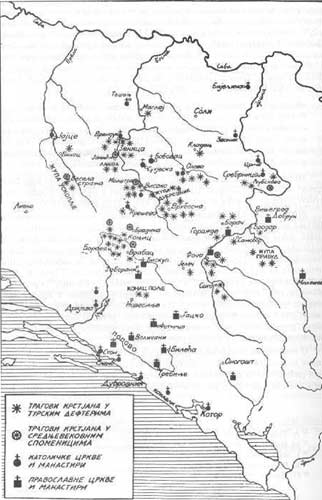
Map
23
Locations of churches in Bosnia before the arrival of the
Ottomans
(S. Cirkovic "Istorija srednjovjekovne bosanske drzave")
Musing
over conspicuous absence of the Orthodox churches and monasteries,
historian Ciro Truhelka remarked:
"In
the region between Drina, Neretva and the Adriatic Sea and
to the north to the river Sava, in the medieval times, there
is absolutely no indication of existence of any Orthodox church
or monastery. Only on the other side of the Neretva river,
in the land of Hum (Hercegovina), which for a time was under
Serb sovereignty, existed a church in Trebinje and a monastery
at Ston. This last one was secularized after Dubrovnik purchased
Ston and Rat in 1333, and the monks left for Jerusalem. The
first Orthodox churches and monasteries only began to be built
in the second half of the 16th Century. That is when a host
of monasteries were built in eastern Bosnia: Tavna (Tamna),
Ozren (1577), Papraca and Lomnica (1597), all in the same
era and built by the same builders".42
As the
Serbian Orthodox Church spread its influence as a part of
the Ottoman state apparatus, the Croatian Catholics were able
to seek refuge within the Orthodox faith. That is why many
Catholics (especially in eastern Bosnia and Hercegovina) converted
to Orthodox Christianity.43As a result of the Ottoman invasion,
large Croat populations fled, and their land was settled by
Orthodox Wallachians as loyal subjects of the Ottoman empire.
The sturdy cattle grazers, but some of them also farmers,
they were granted land for their service in the Ottoman army.
The Ottoman onslaught changed the demographic structure of
Bosnia: those Catholics that converted to the Orthodox faith,
as well as Orthodox Wallachian settlers, eventually, through
the assimilative sociocultural activities of the Serbian Orthodox
church, have become a part of the Serb nation.44 A change
in Bosnian dialects is also a byproduct of the demographic
changes (see maps 4a, b, and c). With the settlement of the
Wallachians and their eastern-hercegovinian dialect the compact
region of western stokavian dialect was broken up. The widespread
use of the new dialect is easily observed in majority Serb
areas. Even the dialects chart of the pre-Ottoman and Ottoman
times thus shows that Orthodoxy came to Bosnia as a result
of the Ottoman conquest. The intrusion of the new dialect
and Orthodoxy into Bosnia continued towards the Croatia proper
regions where sudden demographic changes took place, which
is supported by the decline of the old Croatian "cakavian"
sub-dialect. (map 3, maps 4a, b and c). We can thus agree
that sophisticated analyses of demographic movements and dialects
before and after the arrival of the Ottomans definitely puts
the theory of the Serb character of medieval Bosnia to rest.

The road to the Bosniak nation
Up until
the 19th century, historical sources claim that Bosniaks of
all three faiths (Catholics, Orthodox and Muslims) live in
Bosnia. That identity was not brought into question by the
Turkish authorities, nor by the Bosniaks themselves.50After
the Serb rebellions, a process whereby the Orthodox Bosniaks
became a part of the Serb nation began, helped along by religious
and state propaganda. Bosniak-Muslim scholar Z. Hadzidedic
points out that the nationalization of the Bosnian Orthodox
has full legitimacy because nation is a political and sociocultural
category.51As far as the nationalization of the Bosnian Catholics
is concerned, Hadzidedic believes that it was only completed
in the 1940's, and that it was a reaction to the growing nationalism
of the newly nationalized Orthodox adherents.52 Complex issues
surrounding the creation of the Bosniak nation, definitely
completed in a bloody divorce, cannot be fully understood
if we don't know the opinions of Bosnian Muslim historians.
Of course, the opinions of these authors need to be critically
analyzed, because they only now have the opportunity to create
and define the focal points of their national identity. Even
if we respect their opinions, we need to acknowledge the possibility
that their approach could take on the characteristics of national
romanticism, like the Croat and Serb history had in the last
century.
A Catholic-Orthodox-Muslim
Bosnian nation could never have been idyllic. In the Bosnian
Pashaluk, the Ottomans infused the indigenous islamised population
with the idea of statehood (Turkish-Oriental variant) and
helped shape a new, fiercely loyal ethnicity, which is a unique
case in all the European lands under their occupation. Christian
populations always harboured fears of dominant Islam, and
the fact that some Franciscans wholeheartedly embraced the
idea of the Bosniak nation remained a historical oddity. Fears
of religious communities increased at the time of the Ottoman
withdrawal. Islam, which previously threatened Croatia's existence
in particular, was now on the defensive on all fronts and
could not expect any mercy from the Christians. The Ottoman
Empire came under attack from Christians whose minds were
full of grim memories (real and imagined) of islamic yoke.
Inside the Empire, in the Bosnian Pashaluk, a socio-religious
rebellion against the Turks, ie. Bosnian Muslims was an expected
byproduct. An ecumenical Bosniak nation could not have been
anything but a stillbirth.
By accepting
Islam, the Bosniaks entered a new culture and gained Sultan's
protection, but on the other hand accepted a great risk, a
risk which they were not aware of at the time. That risk consists
of living surrounded by unrelenting enemies, and those enemies
are neighbours of another denomination who could not accept
the Muslim ascendancy, nor forget what it entailed. The risk
was that our "Turks" frequently got punished for
everything the Ottomans had (or hadn't) done in these regions.

Fear rules over Bosnia
Croats
(and Serbs) remember many cruel and demeaning acts perpetrated
by the Muslims, who acted as the protected privileged caste.
These include many pogroms and murders of Franciscans, as
well as the sale of Croats into slavery.57 As the decline
of the Ottoman Empire set in, at the end of the 16th century,
the Orthodox population came under increased attacks, and
Sinan-Pasha in 1594. burned the bones of the Serbian Saint
Sava. Acts like these gave impetus to collective revenge,
or externalization of the aggression. The weakening of the
Ottomans brought great fear and uncertainty to the Muslim
population of Bosnia. In Christian offensives, the Bosnian
Muslims were to pay for the sins of the Ottomans. The Christian
armies acted brutally in showdowns with Islam. Sarajevo was
razed to the ground in 1697.
Having
come to the realization that the Ottomans could no longer
provide them with adequate protection, Bosnian Muslim aristocrats
rebelled in order to keep their superior status and to get
autonomy (Gradascevic's movement) within the Empire. All this
resulted in repressive measures against the Bosnian nobility
and other prominent members of Bosnian Muslim community. The
events of the 19th Century opened up the cracks in the relationship
between the Bosnian Muslims and the Ottoman Empire, but also
between the Bosnian Orthodox and Catholics, who kept neutral
or sided with Austria-Hungary or Serbia & Montenegro61
throughout the dispute which culminated in the occupation
of Bosnia and Hercegovina in 1878.
The bloody
conflict on the eve of the 21st century is the culmination
of a centuries old development (one might say, an inevitable
working out of historical fatality) that was falsely considered
to have ended in WW2, when in the name of Greater Serbia the
Bosniak-Muslims had been objects of a genocide.63 This time
around, things were "modernized". Greater Serbian
aggressive policy unleashed an instrumentalized aggression
(intensified chiefly via media manipulation)64 The repressed
explosive compound of fear and malign aggressivity was already
present (although in a subdued form) at a tribal level among
the Bosnian Serbs.
It is
clear that the bloody conflict at the time of the breakup
of Yugoslavia was a result of the clash between different
historical and national aspirations/tensions that have been
building up for centuries. Three national ideas, at least
as memories (or powerful myths), are a historical truth. The
first national ideal is that of the medieval Bosnia, which
was occupied by the Ottomans in 1463. That kingdom could have
been a basis for the creation of a nation comprised of the
indigenous population, Croats and Bosniak-Muslims. The second
national ideal or outcome relies on Croatia, since many Croatian
historical regions are a part of today's Bosnia and Hercegovina.
This idea was taken further by claims that Croatia extended
all the way to the Drina river, but that cannot be proven.
Of course, the claim that Bosniak-Muslims are "actually"
Croats (without knowing it) fits neatly into this theory.
The third
national ideal is based on the existence of a separate Bosnian
Pashaluk, which spread from the initial core onto Croatian
regions. The fourth national ideal, the Serb one, has no grounding
in history, because there had never been a Serbian kingdom
here that could be the foundation for a modern nation. This
ideal can only be realized through brute force, ethnic cleansing
and falsifying history where the most surrealist absurdity
is the oft used Serb call to the Muslims - to "return
to their forefathers's faith - Orthodoxy". The conflict
between the above ideals, the flames of which are fanned by
the Serbian state in order to create a Greater Serbia, is
horrific. Geopolitically, as we have observed, Bosnia is not
worth much without Croatia. Since this panoramic view of conflicts
between national ideals shows that Serbs have learnt the geopolitical
lesson (but have, due to overtaxing of their energies, failed
to accomplish the Greater Serbia masterplan), one is left
with conclusion that Croats and Bosniak-Muslims are still
groping in historical wastelands.
 |
